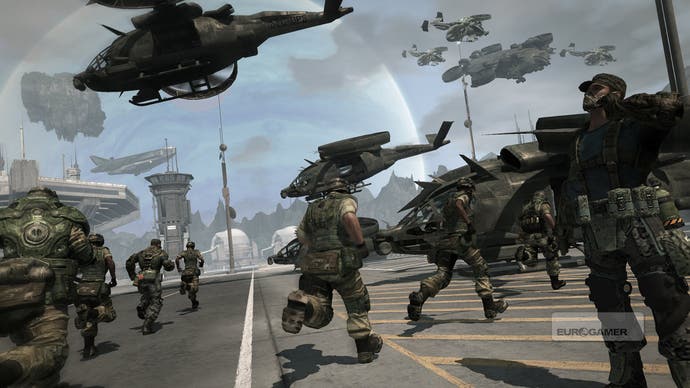James Cameron's Avatar: The Game
Purple pain.
While the order you visit locations and your focus once there is very different for each campaign, you are also running around Pandora in both cases, and so whichever path Ryder takes you still get to enjoy the lush environments Ubisoft Montreal has pulled together using a modified Far Cry 2 engine. Alien blossom and petals flutter on the breeze amidst bright, kaleidoscopic fauna, misty rivers and the soaring highways of broad boughs and jostling canopy. Some will mock James Cameron's vision of an alien planet (choice quote from one friend of Eurogamer: "Did it really take him 10 years to come up with a blue horse?") but it's nice to be in a colourful world for once (and besides, the horse has four front legs, and you can ride on it).
Initially, it really is the world and its mysteries that draw you in. The RDA soldiers discuss the massive fences they had to erect because otherwise the plants literally bite your arms off; there's panic in the ranks as sirens go off to signal the local fauna stampeding the barricades; and your weapons seem flimsy in the face of so much implied threat. Even when you get out amongst it, the game works to maintain that sense of being lost in the unknown, whether as isolated, overmatched RDA troops out in the wild or as a not-quite-Na'vi with much to prove, a traitor to your real species.
However, things take a turn for the worse around the time you realise implication is about the worst of it. There is often a sense of grind to the first few missions in a vast adventure - even brilliant Ubisoft games like Assassin's Creed II take a while to get going - but unfortunately the pattern is stuck once set: you're simply asked to wander between distant yellow markers on the map screen, then dispatched to another marker, sometimes to fetch plants, sometimes to speak to particular people, or sometimes to get in a fight. What little variety there is also finds itself undone by a lack of imagination beneath the surface: an unusual Na'vi mission, for instance, has you fighting an RDA dropship, but just has you doing the same thing three times (climb a ladder, effectively), and the third time is actually the first location again.

Nothing Avatar does upsets your expectations of a game in this genre, but the core combat on both sides also fails to carry this lack of variety, and despite the constant accumulation of experience points, there's little progression to the weaponry. On the Na'vi side you use the bow and arrow at distance, and switch to blades or a staff for button-mashing melee attacks. You can string five hits together to activate a special, but the lack of tactile feedback in close quarters is deflating, and control is imprecise. On the RDA side, you have ranged weapons, but the Na'vi mainly run (and even teleport, infuriatingly) right up to you, so you spend a lot of time flailing, and the lack of hit response makes it difficult to appreciate kills.
There's no subtlety in either case. As a Na'vi, Ryder can use the jungle to avoid skirmishes in some cases by sticking to thick, elevated tree branches, but there's little opportunity to use it to your advantage in combat - something the Ewoks mastered in 1983. Enemies are pretty much the same throughout the game and their AI is poor, and sometimes bugged too, with plenty of running against walls and both sides reliant on being able to aim flawlessly over distance, rather than having any tactical nous.








